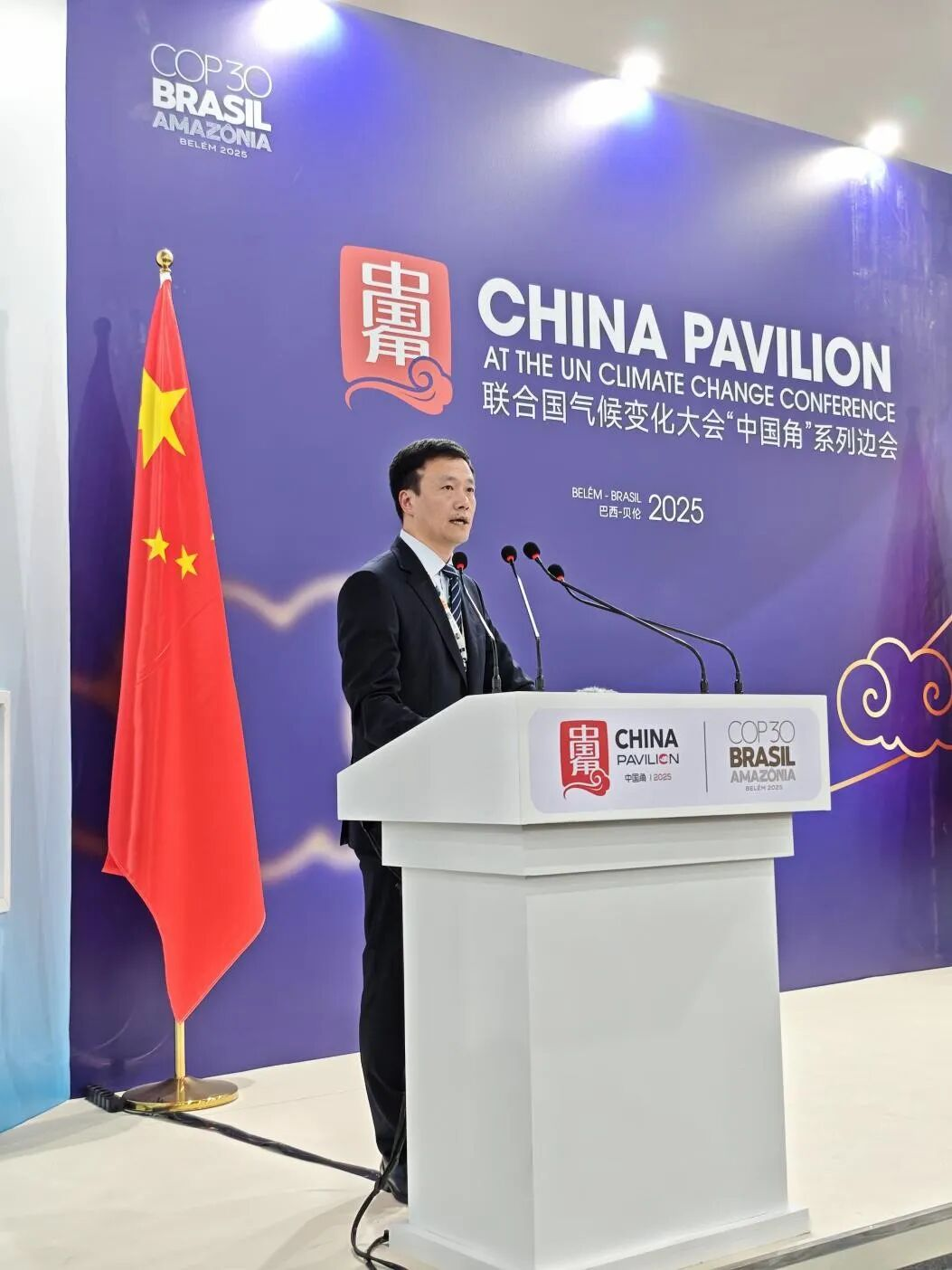

Date issued:2025-11-13
Spotlight on COP30 | Chinese Academy of Environmental Planning Co-Hosts Side Event on the Carbon Market at UNFCCC COP30
Belém, Brazil, November 11, 2025 – The side event themed "High-Quality Development and Experience Sharing of China's Carbon Market" was successfully held at the China Pavilion of the 30th Session of the Conference of the Parties (COP30) to the UN Framework Convention on Climate Change (UNFCCC). The Chinese Academy of Environmental Planning (CAEP) under the Ministry of Ecology and Environment co-hosted the event.

In the "Achievements and Case Sharing" session, Lei Yu, Director of the Center for Carbon Neutrality, delivered a keynote report titled "Effectiveness Evaluation of China's National Emissions Trading System (ETS)". He systematically presented CAEP's research outcomes on the national carbon market, assessing the policy effects from multiple dimensions including fulfilling emission reduction targets, lowering abatement costs, and driving technological innovation. The report garnered extensive attention from domestic and international guests present.
The national carbon market has become a key policy tool for China to implement its national strategy of actively addressing climate change and advance the goals of carbon peaking and carbon neutrality. Since its launch in July 2021, the national carbon market has achieved a phased leap from local exploration to national unification, and from single-industry coverage to multi-sectoral expansion. Through institutional innovation and practical exploration, it has developed a carbon pricing mechanism with distinct Chinese characteristics and a management system that combines local adaptability with international reference value. Among them, the quota allocation mechanism integrating intensity control and dynamic adjustment, the comprehensive data governance system supported by both institutional innovation and technological empowerment, and the strict and effective compliance and settlement system are all important foundations for the efficient operation of the national carbon market at China's current stage.
The assessment results show that China's national carbon market has promoted a reduction in the carbon emission intensity of the power generation industry, with the CO₂ emission intensity of power generation units covered by the carbon market dropping by 2.9% cumulatively from 2019 to 2024. It has slowed down the growth rate of total carbon emissions in the power generation industry — compared with the predicted results of a "no-carbon market" scenario, the carbon market has cumulatively driven a reduction of 357 million tons in total carbon emissions of the power generation industry. It has effectively achieved low-cost emission reduction, cutting social emission reduction costs by approximately 40.5 billion yuan. The above assessment results indicate that for developing countries, an intensity-based carbon market can effectively curb the growth of greenhouse gas emissions while meeting the needs of economic development.
The assessment also found that China's national carbon market has significantly accelerated the large-scale application of green and low-carbon technologies. It has prompted 65% of enterprises to increase investment in carbon reduction projects, with 27% of them investing over 100 million yuan. Meanwhile, the national carbon market has boosted China's low-carbon technological innovation. Since its launch, the number of patent applications related to the carbon market has seen a substantial surge — a year-on-year increase of 140% in 2021 and more than 4,000 applications in 2024. There is a significant correlation between carbon prices in the market and the number of patents: for every 1-yuan increase in the carbon price, the number of low-carbon patents rises by 1.03.
The results of the questionnaire survey organized during the assessment show that driven by the carbon market, enterprises have generally established internal carbon emission management mechanisms, and carbon management has gradually become institutionalized and professionalized. Seventy-two percent of key emission units have set up full-time carbon asset management departments, and 87% of enterprises believe the carbon market has a significant impact on their overall investment decisions. Enterprises' annual management expenditures related to the carbon market show a continuous growth trend, with an overall improvement in market awareness and governance capabilities. Enterprise-level intelligent carbon emission control platforms are emerging continuously.
The aforementioned assessment was conducted by the Center for Carbon Neutrality of Chinese Academy of Environmental Planning. In recent years, the center has developed the "China Carbon Market Comprehensive Assessment Model (CMODE)" and the "China Low-Carbon Technology Assessment and Simulation Platform". It has gradually established a full-industry emission reduction technology database and carried out in-depth research using these technical tools, laying a solid foundation for core tasks in China’s carbon market development such as top-level design, effectiveness evaluation, and quota allocation. Moving forward, the academy will further advance research on relevant technical methods. In accordance with the work arrangements of the Ministry of Ecology and Environment, it will deepen research on carbon pricing theories and methodologies, strengthen the tracking and evaluation of the carbon market, and continue to provide strong technical support.
 Comments
Comments




 Home
Home

 京公网安备 11010702002483
京公网安备 11010702002483